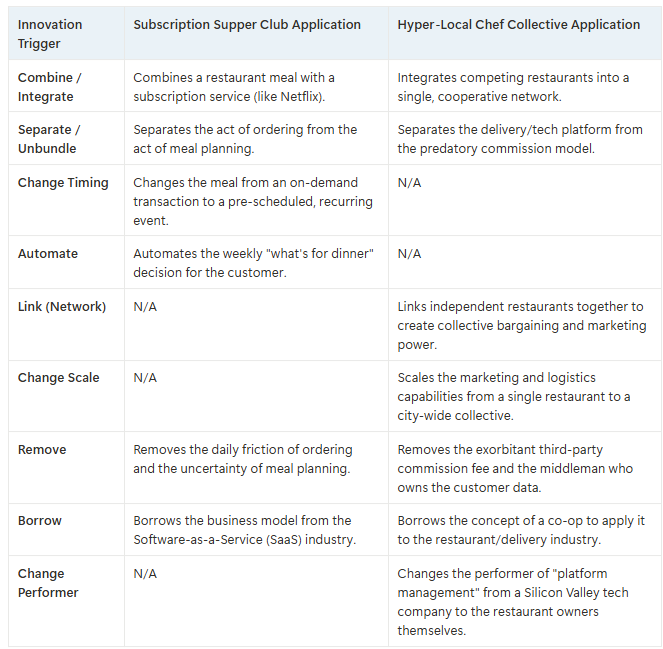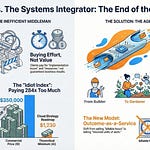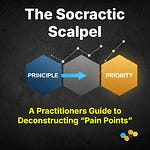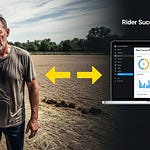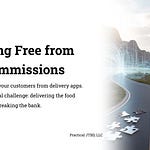Introduction: The Unwinnable War
Let's be honest. It feels like you're under siege. Every day, you pour your heart into creating incredible food and a welcoming atmosphere, only to watch a fleet of anonymous drivers carry your hard work out the door in a plastic bag. And for that privilege, a tech company a thousand miles away takes a 20%, 25%, sometimes even 30% cut of your revenue.
They call themselves your "partners," but it feels more like a parasitic relationship. They feed on your margins, control your access to the customers who love your food, and hold your own business data hostage. They’ve wedged themselves between you and your community, and you’re told it’s just the cost of doing business today. You’re told you have to be on their platforms to survive.
What if that’s a lie?
What if the very thing that makes them powerful—their massive, ravenous user base—is the key to your liberation? What if you could stop being the host and start using the parasite’s own strengths against it, turning its platform into your most powerful customer acquisition machine?
This isn’t wishful thinking. It's a strategy. It’s a way of thinking rooted in a powerful innovation methodology called Jobs-to-be-Done (JTBD). It’s a playbook that shifts your perspective from seeing delivery apps as a sales channel to seeing them as a marketing expense—a tool to be exploited.
In this deep dive, I’m going to lay out the entire strategy for you. We’ll break down the problem to its absolute core, understand what your customers are really trying to accomplish when they open that app, and build a step-by-step plan to convert their users into your loyal, profitable, first-party customers. Then, we'll look beyond this immediate strategy to explore novel business models that could define the future of a resilient, independent, and wildly profitable restaurant industry.
It's time to stop playing their game. Let's build a new one.
A First-Principles Look at the Great Margin Collapse
Before we can architect a solution, we have to dismantle the problem. Reasoning by analogy is what got the industry into this mess. "Everyone else is on DoorDash, so I have to be too." That's looking at what others are doing and copying it. First principles thinking, on the other hand, forces us to ask: what is actually true here?
Let's break it down.
Step 1: Identify and Define Your Current Assumptions
When you sign a contract with a third-party delivery platform, you are operating on a set of assumptions. Be honest, these probably sound familiar:
"I need delivery apps to reach new customers who wouldn't find me otherwise."
"My customers want the convenience of ordering through an app they already use."
"If I'm not on the apps, my competitors will get all the delivery business."
"A 25% commission is painful, but it's better than an empty kitchen."
These are the conventional wisdom. But they are not fundamental truths.
Step 2: Break Down the Problem into its Fundamental Principles
What are the absolute, undeniable truths of this situation?
You create a product. You source raw materials (ingredients) and transform them into a finished good (a meal). This has a real, tangible cost (Cost of Goods Sold - COGS).
You have fixed operational costs. Rent, labor, utilities, insurance. These must be paid whether you sell one dish or one hundred.
Profit is the remainder. Profit = Revenue - COGS - Fixed Costs - Marketing Costs. This is the only money you have to reinvest, grow, and pay yourself.
Customers want to get a "job" done. In this case, the basic job is get a satisfying meal without having to cook it myself.
A middleman exists. The delivery app is an intermediary that connects a customer who wants to get the job done with a provider (you) who can do it.
The core problem isn't the existence of the middleman; it's the price the middleman charges for the connection and the value it provides in return. The assumption is that the value (new customers, logistics) is worth the 25-30% commission. A first-principles analysis forces us to ask: is it?
Step 3: Reconstruct a New Solution From Scratch
Let's visualize the brutal math. Imagine a solid, well-run restaurant, "The Local Bistro."
Financial Model 1: The Pre-App Era (Dine-in & Direct Takeout)
Here's a simplified look at a single $50 order.
Item Cost Percentage of Sale Revenue $50.00 100% COGS (Food Cost) -$15.00 30% Labor -$15.00 30% Rent & Utilities -$7.50 15% Marketing & Other -$2.50 5% Gross Profit $10.00 20%
A 20% margin is healthy. For every $50 that comes in, you pocket $10. Not bad.
Now, let's introduce a third-party app. Let's be conservative and say they take a 25% commission. Many take more. Let's see what happens to that same $50 order when it comes through their platform.
Financial Model 2: The "Partner" Era (Same $50 Order via App)
Item Cost Percentage of Sale Revenue $50.00 100% App Commission Fee -$12.50 25% Net Revenue $37.50 75% COGS (Food Cost) -$15.00 30% (of original) Labor -$15.00 30% (of original) Rent & Utilities -$7.50 15% (of original) Marketing & Other -$2.50 5% (of original) Gross Profit -$2.50 -5%
Read that again. On the exact same order, you just lost $2.50.
The fundamental truth is that your cost structure is based on the original $50 of revenue. The food doesn't get cheaper because the order came through an app. Your cooks don't take a pay cut. Your landlord doesn't give you a discount.
The app inserts itself at the very top, slicing its share off before you can even begin to cover your own costs. For many restaurants, a significant portion of their orders are now actively losing them money. They are paying to give their food away. This is not a sustainable business model; it's a slow-motion liquidation.
The first-principles conclusion is stark: An order taken through a third-party app cannot be treated as a normal sale. The assumption that it's just another revenue stream is false. It's a fundamentally different, and often unprofitable, transaction.
So, if it's not a sale, what is it?
This is where we begin to reconstruct our new solution. We must redefine the transaction. The 25% commission is not a partnership fee; it is your Customer Acquisition Cost.
The Job Beyond "Getting Food": A JTBD Masterclass for Restaurateurs
If we're going to treat app orders as a marketing expense to acquire a customer, we need to understand that customer far more deeply than the app does. The apps see a user, a data point, an order history. You need to see a person trying to make progress in their life. You need to understand their Job-to-be-Done.
The core concept of JTBD is that people don't buy products or services; they "hire" them to get a job done. And that "job" is rarely just about the functional task at hand. It's layered with emotional and social needs that are often far more powerful drivers of behavior.
Let's map the Job of getting a satisfying meal at home.
The Core Functional Job Map
Any job can be broken down into a series of process steps. For your customer, it looks something like this:
Define: The initial moment of need. "I'm hungry, and I don't want to cook tonight. What should I do for dinner?"
Locate: The search for options. This involves gathering information, checking what's open, and seeing what's available for delivery. This is a key step where apps dominate.
Prepare: Making a decision. This is about comparing options, reading reviews, checking prices, and getting buy-in from family members.
Confirm: Finalizing the choice. "Okay, we've decided. Let's order from The Local Bistro." This step requires having confidence in the choice.
Execute: Placing the order and making the payment. This needs to be as frictionless as possible. This is another step where apps excel.
Monitor: Tracking the progress. "Has the order been received? Is the food being prepared? When will the driver arrive?" The apps have weaponized this with real-time maps.
Modify: Making changes. This is rare, but could involve adding an item or correcting a mistake. It's often a point of high friction.
Conclude: Receiving and consuming the meal, and dealing with the aftermath (cleanup). The job isn't done until everyone is fed and satisfied.
The delivery apps have built billion-dollar empires by being world-class at three of these steps: Locate, Execute, and Monitor. They provide a massive, easily searchable directory, a one-click payment system, and a GPS dot that gives the illusion of control.
But they are remarkably bad at the other steps, and they completely ignore the most important drivers of all.
The Emotional and Social Jobs
This is where you have the home-field advantage. No one opens DoorDash because they have a deep, emotional connection to the DoorDash brand. They use it as a utility to fulfill a deeper job. What's really going on in their life at that moment?
Emotional Job (Internal):
Relieve the stress and cognitive load of meal planning. The customer isn't just hiring you to cook; they're hiring you to make a difficult part of their day disappear.
Feel like a good parent, partner, or provider. Bringing home a delicious, high-quality meal is an act of care. They want to feel like a hero for solving the dinner problem.
Indulge in a moment of comfort and reward. Sometimes, the job is simply "I had a terrible day, and I deserve this."
Avoid the risk of a bad experience. They are desperately trying to avoid a meal that is late, cold, wrong, or just plain disappointing.
Social Job (External):
Be seen as someone with good taste. Ordering from a respected local spot carries more social capital than ordering from a generic chain.
Facilitate a shared social experience. The job might be "have a fun movie night with the family" or "host a game night without the stress of cooking." Your food is the fuel for their social interaction.
Be seen as someone who supports local businesses. For many customers, there's a genuine desire to connect with and support their community.
The apps are transactional. They can't do this. They can't make a customer feel seen, understood, or valued. They can't connect with the parent who is exhausted after a long day of work and just wants to see their family happy around the dinner table.
But you can.
The entire "Parasite Strategy" is built on this insight. You will use the app's cold, transactional efficiency to initiate the relationship, and then you will take over and win the customer's loyalty by brilliantly fulfilling their deeper emotional and social jobs.
The "Parasite Strategy": A Step-by-Step Implementation Playbook
Okay, let's move from theory to action. This is the tactical, step-by-step guide to turning third-party app users into your customers. This system requires discipline, a small investment in materials, and a fundamental shift in mindset.
Step 1: The Math of Acquisition
First, you must internalize the mantra: The app commission is my Customer Acquisition Cost (CAC).
Every time an order for "The Local Bistro" comes in from Uber Eats, you must not see it as a $50 sale with a $12.50 fee. You must see it as a marketing campaign where you just paid Uber Eats $12.50 to deliver you a brand new, qualified lead who is proven to like your food.
Is that a good price? Let's compare. How much do you spend on other marketing?
Facebook Ads: You might spend $500 to reach 20,000 people, get 200 clicks, and maybe 10 new orders. Your CAC there is $50 per customer.
Local Mailers: A 5,000-piece mailer might cost $2,500 and bring in 50 people. Your CAC is $50.
Suddenly, paying $12.50 to acquire a customer who is already eating your food seems like a bargain, doesn't it?
The only way this CAC is a good investment, however, is if you have a system to convert that customer and generate future, high-margin sales from them. If you just let them order from the app again and again, you're not acquiring a customer; you're just renting them at an extortionate rate.
Step 2: Engineering the "Switch": The Art of the Irresistible Direct Offer
This is the lynchpin of the entire strategy. Your goal is to place a message inside that delivery bag that is so compelling, so value-packed, that it convinces the customer to break their app habit and come directly to you for their next order.
This cannot be a flimsy business card or a boring "10% off your next order" flyer. It must feel like a discovery. It must feel like a gift. It must create value. I call it the "Golden Ticket."
Golden Ticket Principles:
High-Quality Physical Object: It should be printed on thick, satisfying card stock. It shouldn't feel like junk mail. It's a physical representation of your brand's quality.
It's a Personal Message: It should be written from you, the owner. "A Note from Chef Sarah" or "A Gift from Our Family to Yours."
Acknowledge & Thank: Start by thanking them for their order. Acknowledge that you know they have a million choices (especially on the app) and you're grateful they chose you.
Reveal the "Secret": Let them in on the problem. Be transparent. "When you order through an app, they take a big cut that makes it hard for local spots like us to survive. But when you order directly from us, you help us keep our doors open, support our amazing staff, and invest back into our community."
Make the Irresistible Offer: This is the call to action. It must be significantly better than any offer they could find on the app.
Examples of Irresistible Offers:
The Experience Upgrade (Best for most): "As a thank you, your next order is special. Scan this QR code to order directly from us and get our famous [High-Margin Signature Dessert/Appetizer] for FREE. No strings attached. This is an exclusive offer for our first-time direct customers."
Why it works: It's not a discount; it's an upgrade. You're giving them a taste of a premium item, anchored to the experience of ordering direct. The perceived value is high, but the actual cost to you is low (your COGS on that dessert might be $2.00).
The Bounce-Back Credit: "Thank you for your order! We've loaded a $15 credit for you to use on your next order of $40 or more. Scan the QR code to claim it on our website. (This credit is only available through our direct ordering site)."
Why it works: It feels like found money. It creates a powerful incentive to return and establishes a higher future order value.
The Loyalty Kickstart: "Welcome to the family. Scan this code to order direct and we'll not only give you free delivery, but we'll automatically enroll you in our loyalty club and start you with 50 bonus points (that's halfway to a free entree!)."
Why it works: It plays on long-term value and belonging. You're not just offering a transaction; you're inviting them into an exclusive club.
The QR code is non-negotiable. It must take them directly to your first-party ordering page, with the offer pre-loaded or easily entered. You are removing every possible point of friction.
Step 3: Building Your Direct Channel
Your "Golden Ticket" is worthless if it leads to a clunky, broken, 1990s-era website. Your direct ordering experience must be as good or better than the app's. This is non-negotiable.
Keep it Simple: You don't need a custom-coded masterpiece. Services like Squarespace, GloriaFood, Toast, or UpMenu offer excellent, affordable, and often commission-free online ordering systems that can be set up in a weekend.
Mobile First: 90% of these orders will come from a phone. Test it on your phone. Is it fast? Are the buttons easy to press? Is the menu clear?
Frictionless Checkout: Capture only the information you absolutely need. Name, email, phone, address, payment. Don't make them create a password-protected account on the first order. Reduce the process to the fewest possible clicks.
Step 4: From First Order to Loyal Regular: Maximizing LTV
You did it. They scanned the code, used the offer, and ordered direct. The "Parasite Strategy" worked. You paid the app its $12.50 acquisition fee, and now you have something infinitely more valuable than that one order:
You have the customer's data.
Specifically, you have their email address and their order history. This is the asset that builds dynasties. Now, you use that asset to build a relationship and maximize that customer's Lifetime Value (LTV).
The Welcome Email: The moment they place their direct order, an automated email should go out. "Welcome to The Local Bistro's inner circle! Thanks for ordering direct. You're helping to support local, and we won't forget it. Here's what you can expect as a direct customer..."
Simple Email Marketing: You don't need a complex strategy. A simple monthly newsletter with new specials is enough. A "We miss you!" email with a small offer if they haven't ordered in 60 days is even better.
Build a Loyalty Program: The data allows you to reward your best customers, making them feel even more valued and making it even harder for them to go back to the sterile experience of the apps.
The math changes dramatically. That first breakeven (or money-losing) order is followed by a second, third, and tenth order where you keep 100% of the revenue, minus standard payment processing fees. Your profit margin on those subsequent orders jumps back to that healthy 20% or more. This is how you build a resilient business.
Future-Proofing Your Restaurant: Two Novel Business Models
The "Parasite Strategy" is a powerful way to fix the broken model of today. But Jobs-to-be-Done thinking also allows us to look over the horizon and imagine the entirely new models of tomorrow. These are concepts that solve the customer's job in a completely different, better, and often more profitable way.
Model 1 (Working Today, Few Are Doing): The Subscription Supper Club
This model elevates the job from "What's for dinner tonight?" to "How can I effortlessly provide interesting, high-quality meals for my family every week?"
The Concept: Instead of ordering on-demand, customers subscribe to a membership. For a recurring monthly fee, they get a set number of meal "credits" or a curated meal kit delivered on a specific day each week. For example, $250/month for four family meals, one delivered every Tuesday.
The JTBD Solution: This brilliantly solves the deeper emotional job of relieving the cognitive load of meal planning. It removes the daily friction of "Define" and "Locate" from the customer's life. Tuesday's dinner is just... done. It also creates predictable, recurring revenue for you, which is the holy grail of any business. It allows you to optimize inventory, reduce waste, and schedule labor with incredible efficiency. It's a high-margin, sticky solution to a much higher-level customer job.
Model 2 (The Future): The Hyper-Local Chef Collective
This model gets the job done by completely changing the structure of the market, turning a competitive weakness (being a small, independent player) into a collective strength.
The Concept: A group of 10-20 independent, high-quality local restaurants form a co-op. They pool their resources to create their own shared, exclusive, low-commission delivery platform and potentially even their own small fleet of drivers. It's a "by the restaurants, for the restaurants" alternative.
The JTBD Solution: For you, the restaurant owner, this solves the critical job of competing with the scale and marketing power of national tech platforms. For the customer, it solves the social and emotional job of supporting local businesses while still getting best-in-class convenience. It could even become a curated mark of quality; being on the "Local Eats" collective app would be a signal of being one of the best independent spots in town. This model removes the predatory middleman and re-aligns the value in the ecosystem back to the food creators and the local community.
Creativity Triggers Reference Table
How do we come up with novel ideas like these? By systematically applying creative triggers to the problem space. Here’s how these models break down:
Building Your Moat: A Doblin's 10 Types of Innovation Analysis
The "Parasite Strategy" and the novel models we've discussed are powerful because they aren't just a single idea. They are a sophisticated combination of multiple types of innovation. According to research by the firm Doblin, the most successful and defensible businesses don't just innovate in their product; they innovate across multiple fronts. Relying only on a better product is often the easiest thing for competitors to copy. 1
Let's analyze the "Parasite Strategy" using Doblin's 10 Types of Innovation framework:
Profit Model Innovation (Configuration): This is the most profound innovation. You are fundamentally changing how you make money. You're shifting from a low-margin, high-volume transactional model to a high-margin, high-LTV relationship model. The first sale is a marketing cost, and the profit is harvested over the long term. 2
Channel Innovation (Experience): You are actively building a new, more profitable path to your customer: your first-party direct ordering channel. You're innovating
how you deliver your offerings by creating a channel you own and control. 3
Service Innovation (Experience): The "Golden Ticket" and the subsequent loyalty program are innovations in your service. You're adding a layer of service and gratitude that amplifies the value of your core offering and makes the experience of ordering direct superior to the anonymous experience of the app. 4
Customer Engagement Innovation (Experience): By capturing customer data and using it to build a relationship, you are innovating how you foster interactions. You're moving from a passive recipient of orders to a proactive manager of customer relationships. 5
When you combine these four types of innovation, you create a system. It's not just a marketing trick; it's a new business engine. This system becomes your competitive moat. Your competitor can copy your menu, but it's much harder for them to copy your entire business system. This is what makes the strategy resilient and powerful.
Conclusion: From Host to Hunter
The feeling of helplessness in the face of giant delivery platforms is understandable, but it is not a requirement. The power dynamic only exists because we accept the assumptions they want us to accept.
By thinking from first principles, we see that their fees are unsustainable for your business model.
By using the Jobs-to-be-Done framework, we see that they are only solving a fraction of your customer's real needs.
And by applying a multi-faceted innovation strategy, we can architect a new system that turns their greatest strength into your biggest opportunity.
Stop thinking of yourself as a host, passively feeding a parasite that is slowly draining you.
Start thinking like a hunter.
See their platform for what it is: a vast, target-rich environment. Every order that comes through is a lead. Your mission is to use your superior product, your personal touch, and a brilliantly engineered offer to capture that lead and bring them into your own ecosystem, where you can serve them better and build a profitable, long-term relationship.
They built the hunting ground. But you own the real prize: the food, the experience, and the heart of the customer relationship. It's time to take it back.
I want to hear from you. Whether you're a restaurant owner in the trenches, a chef, or just a passionate supporter of local food, join the conversation in the comments below:
What is the single most effective tactic you've used (or seen) to encourage customers to order directly?
For restaurant owners: What is the biggest barrier or unanswered question you have about implementing a direct-ordering strategy?
For customers: What kind of offer would actually convince you to delete a delivery app and start ordering direct from your favorite local restaurant?
Follow me on 𝕏: https://x.com/mikeboysen
If you'd like to see how I apply a higher level of abstraction to the front-end of innovation, please reach out. My availability is limited.
Mike Boysen - www.pjtbd.com
Why fail fast when you can succeed the first time?
Masterclass: https://pjtbd.com/mc
My Blog: https://jtbd.one
📆 Book an appointment: https://pjtbd.com/book-mike
Join our community: https://pjtbd.com/join



